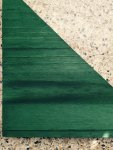pikingrin
what is this?
So I've been watching hours and hours of youtube videos and reading stewmac stuff relating to finishing techniques, which is maybe putting the cart before the horse as I'm not convinced I have a body shape (or electronics and hardware) nailed down yet. The only thing I know is that it's going to be a mahogany body with a flame maple top.
I have been playing around with the dyes that I got though and that is where my main two questions come into play. Is there any difference on how the dyes react when thinned with water versus alcohol? I got a can of denatured alcohol to thin them out and the results were so-so on my first try. Wondering if there would be a difference in the tint if water was used to thin it out though.
My second question is in regards to testing media. I've just been playing around with a piece of scrap edge-glued pine (I've got quite a few laying around) and I'm wondering if that's a good idea or not. I'm not expecting much from the mahogany, it's going to be dyed black, but the flame maple is another story. I will have scraps once I cut the body shape but I was kind of trying to get my technique down using pine - if the colors will translate the same... Any thoughts?
I have been playing around with the dyes that I got though and that is where my main two questions come into play. Is there any difference on how the dyes react when thinned with water versus alcohol? I got a can of denatured alcohol to thin them out and the results were so-so on my first try. Wondering if there would be a difference in the tint if water was used to thin it out though.
My second question is in regards to testing media. I've just been playing around with a piece of scrap edge-glued pine (I've got quite a few laying around) and I'm wondering if that's a good idea or not. I'm not expecting much from the mahogany, it's going to be dyed black, but the flame maple is another story. I will have scraps once I cut the body shape but I was kind of trying to get my technique down using pine - if the colors will translate the same... Any thoughts?



